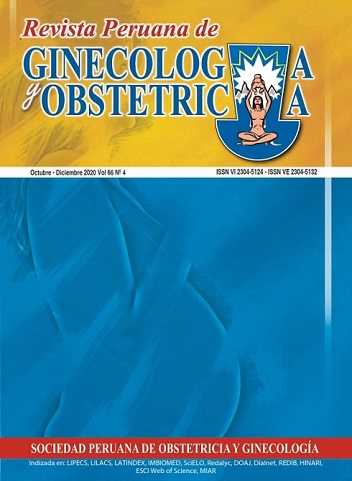Cephalic-abdominal-femoral (C+A-F) index: an effective anthropometric tool to assess fetal growth and its deviation
DOI:
https://doi.org/10.31403/rpgo.v66i2283Keywords:
Fetus, Fetal growth, Fetal weight, Birth weight, Biometry, CAF indexAbstract
Background: Achieving an ideal method to assess the potential for fetal growth is an unfulfilled aspiration in our discipline, and imposes the need for individualized evaluation using new tools and integrated multi-parameters. Objectives: To evaluate correlation and to establish cephalic/abdominal/femoral (CAF) index reference values with gestational age (GA) and estimated fetal weight, in order to classify fetal growth evolution as adequate or not adequate for gestational age, and correlation with weight of the newborn at term. Patients and methods: 1 032 simple and not complicated pregnancies 12 to 38 weeks of gestation were studied at the Polyclinic Center of Valencia, Venezuela, between 2015-2017. Ultrasound measurements and fetal weight were estimated at 3-5 weeks intervals. Studied parameters were head circumference (HC), abdominal circumference (AC) and femur length (FL), integrated in the CAF index = [(HC + AC) - FL] formula. The cubic regression model and Z-score were applied in 256 cases followed up to delivery. Three CAF groups were established: a) CAF <50, b) CAF 50–57, and c) CAF ≥58; the mean ± SD newborn weights were calculated in each group. Results: The CAF index revealed an R² = 0.96, p <0.05 for weeks of gestation, and R² = 0.92, p <0.05 for weight. In 256 cases followed up to delivery, when the CAF index was equal or greater than 58, the newborn weight was 3 361 ± 484 g, with statistically significant differences as compared to the other groups (student test p <0.05). Conclusions: The CAF index is a multiparametric method that allows to determine by serial evaluations the expected individual growth potential and virtually to identify deviations.Downloads
Download data is not yet available.
Downloads
Published
2020-12-03
How to Cite
Sosa-Olavarría, A., Álvarez-Moya, E., Schenone Giugni, M. H., Pianigiani, E. C., Zurita-Peralta, J., & Schenone Giugni, C. V. (2020). Cephalic-abdominal-femoral (C+A-F) index: an effective anthropometric tool to assess fetal growth and its deviation. The Peruvian Journal of Gynecology and Obstetrics, 66(4). https://doi.org/10.31403/rpgo.v66i2283
Issue
Section
Artículos Originales
















